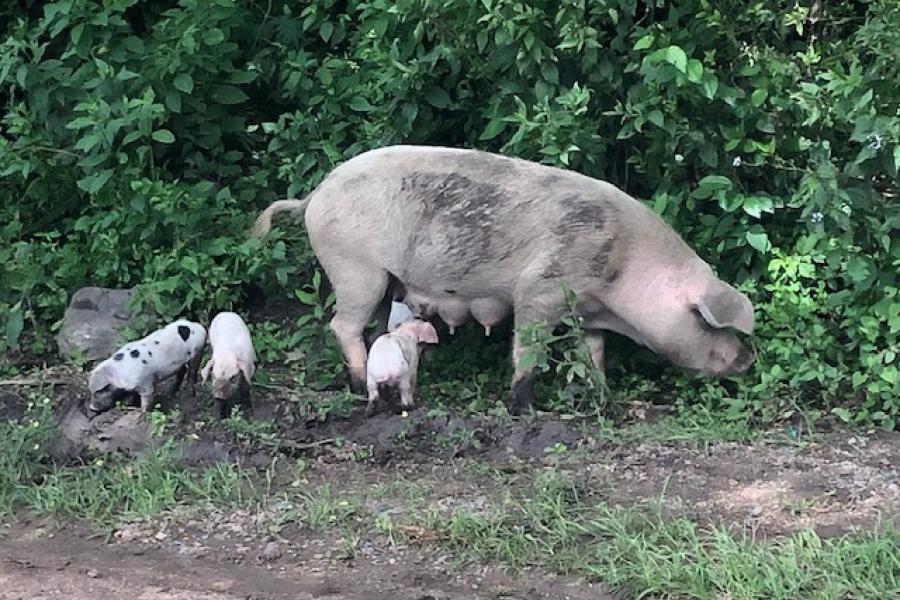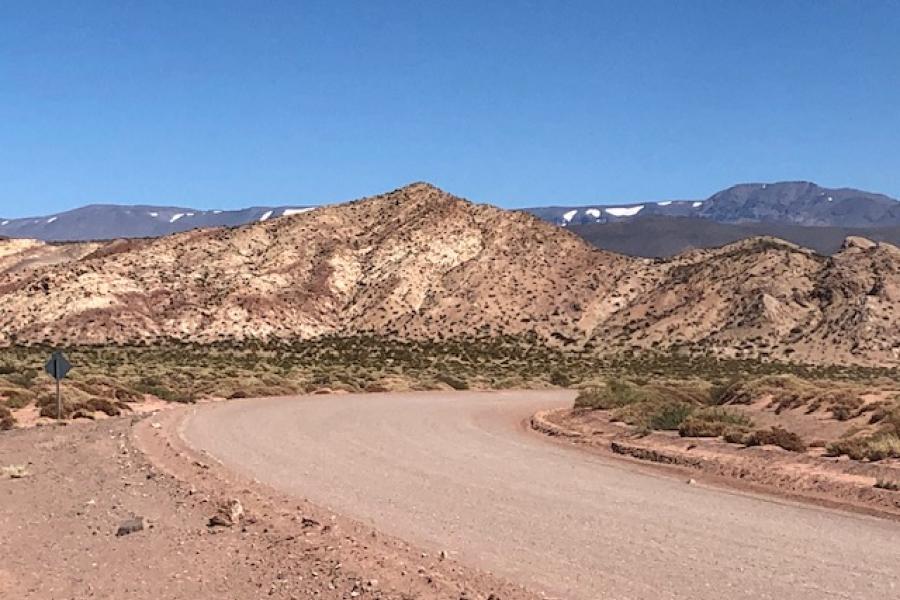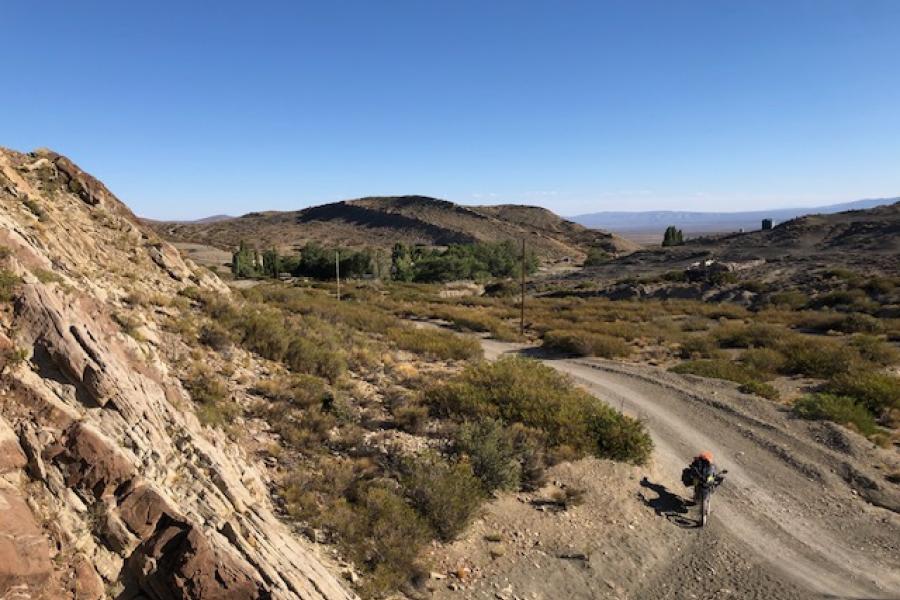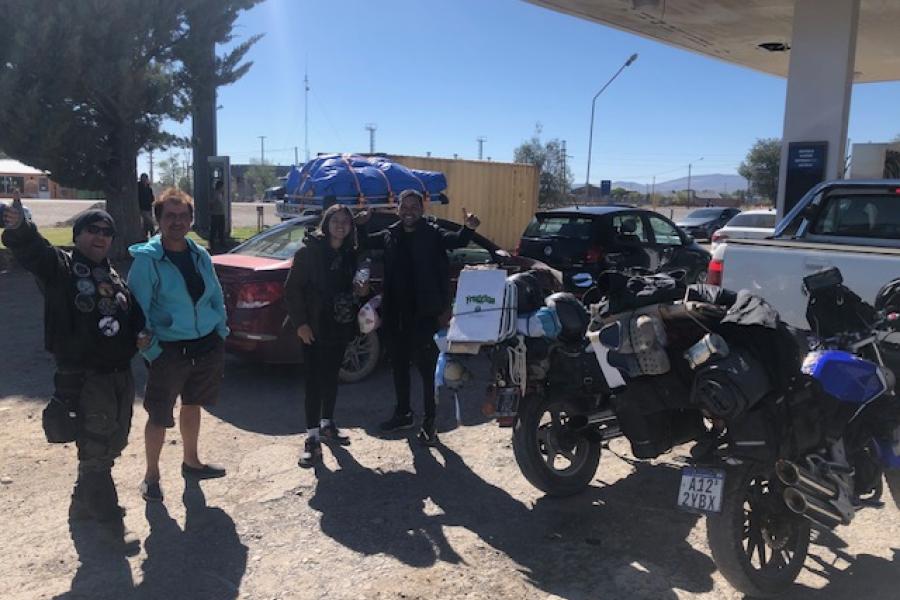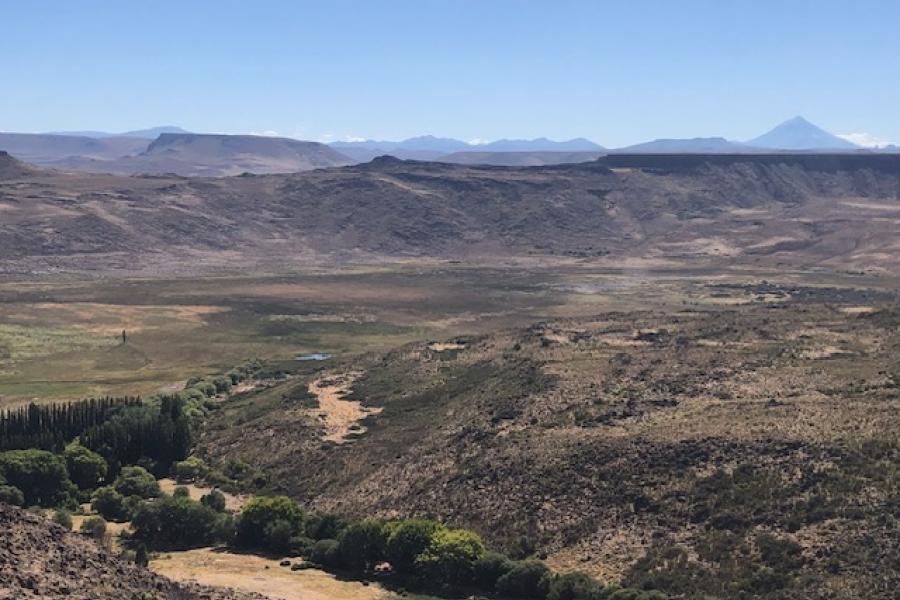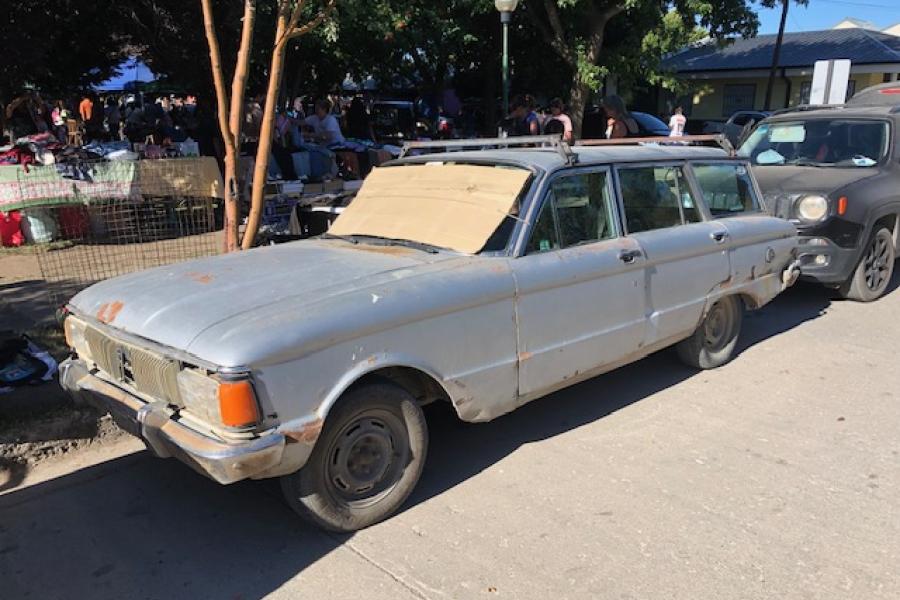Bolivia → Argentina
Country
With Chile not immediately possible, the obvious path was Argentina - keep running south and when a Chilean visa was in hand, criss-cross over all those mountain passes in the photos. This meant retracing steps north east to Uyuni before taking highway 21 south-south-east.
I was all packed and ready to leave San Cristóbal, but saw there was a market that morning spread along the main streets. Every retail category you could imagine was there - from the usual fresh produce and clothes through kitchenware to tools and consumer electronics.
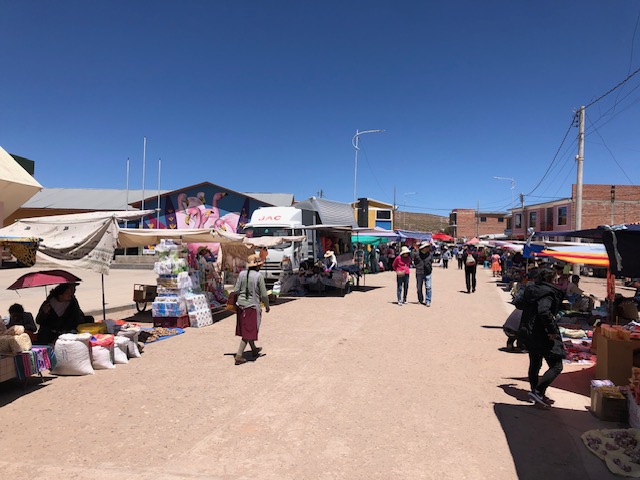
On the way out I bumped into Mateo from Colombia. The steering head nut had worked loose on his V-Strom. With the handlebar risers blocking access, it really wanted a socket from above. All he could manage was a contorted twist with Vice Grips, way less torque than Mr Suzuki called for. At least I could help him with some Loctite.
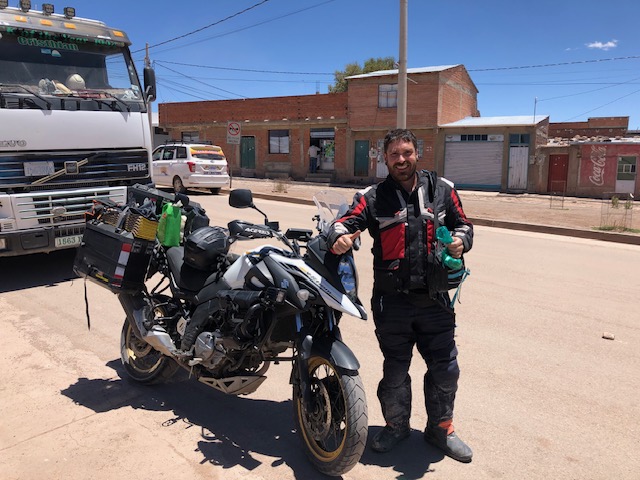
Mateo had crossed the salt flats, but baulked at riding the lake route to Chile. A gregarious fellow, he offered a place to stay if I ever returned to Colombia.
Uyuni, like most Bolivian towns I'd visited, was covered in sand. Central streets were paved, but only a few blocks out they were not. Despite its grimy appearance it sported street artwork, parks, numerous specialty shops, a heap of tourists and as always in such a place a good coffee at gringo prices. This is a "cappuccino", topped with cream and chocolate syrup. A surprise but yummy.
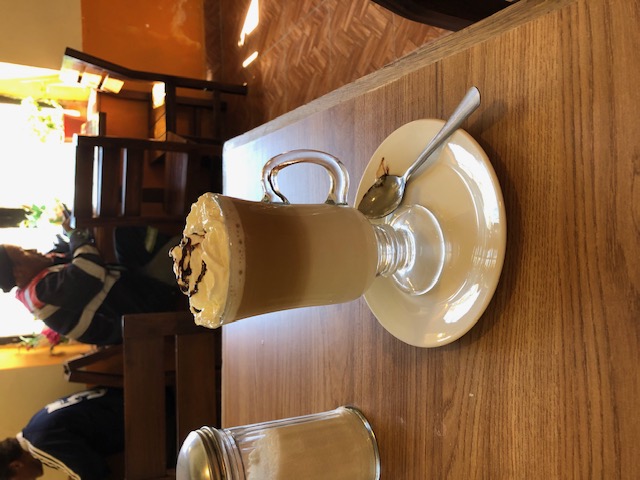
The first hour south of Uyuni was a dead straight highway through sparse flat country.
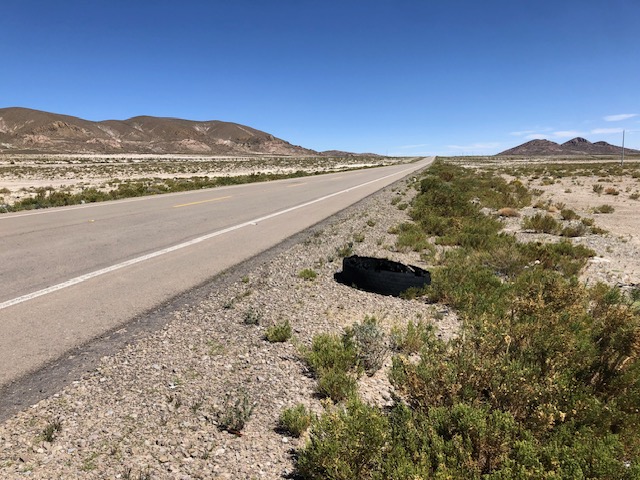
There must have been one or two of these shrine/altar things per kilometre. Why, when the highway was flat, wide and straight?
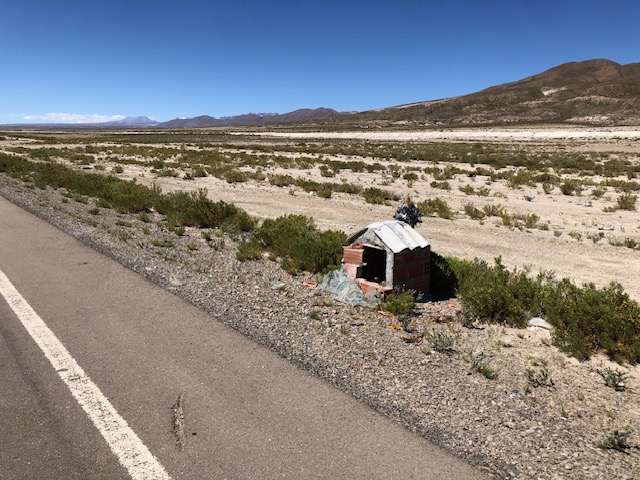
The terrain made for a relaxing hour.
Alpacas were decorated with colourful ribbons and necklaces. Do you think it's for identification or do the farmers really like their wooly friends?
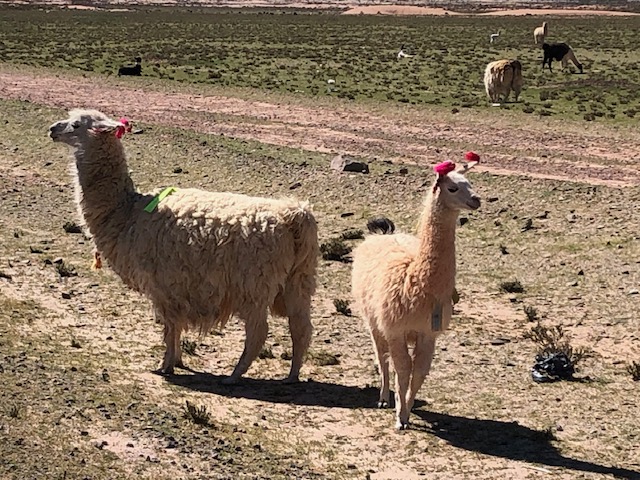
After that first hour the scenery constantly changed: from feeling up on top of the world to being down in a warm valley of fantastic rocks.
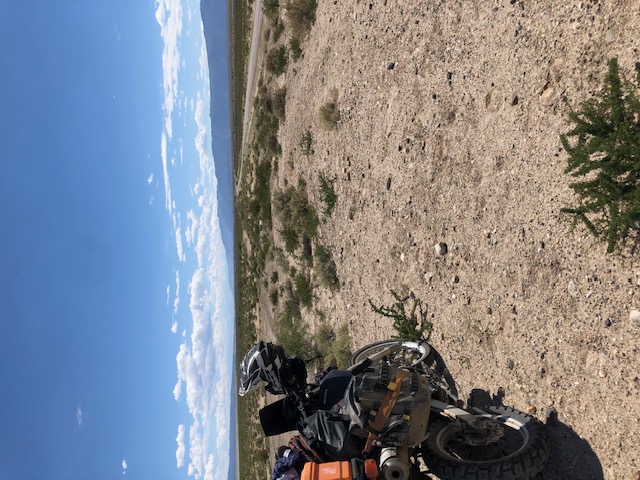
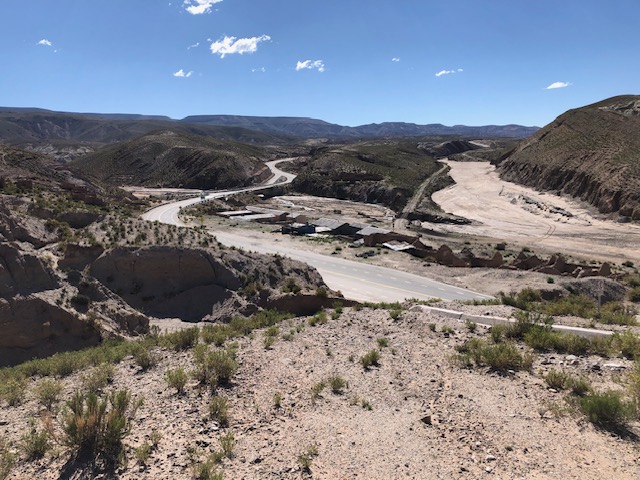

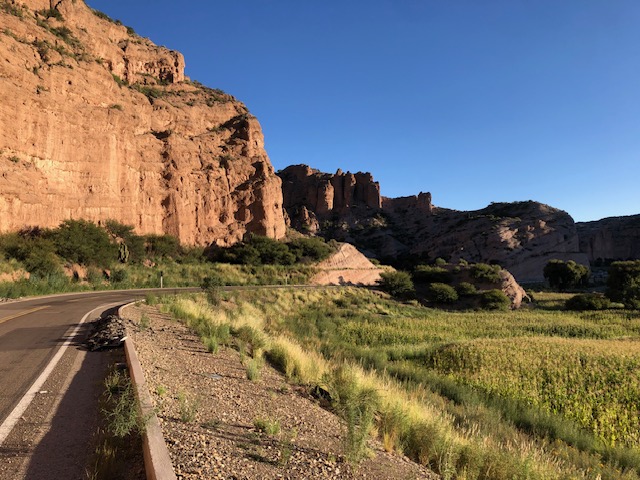
The campsite out of Tupiza was a highlight. I couldn't remember when there was last an easy patch of grass over soil to pitch the tent on. Luxury!
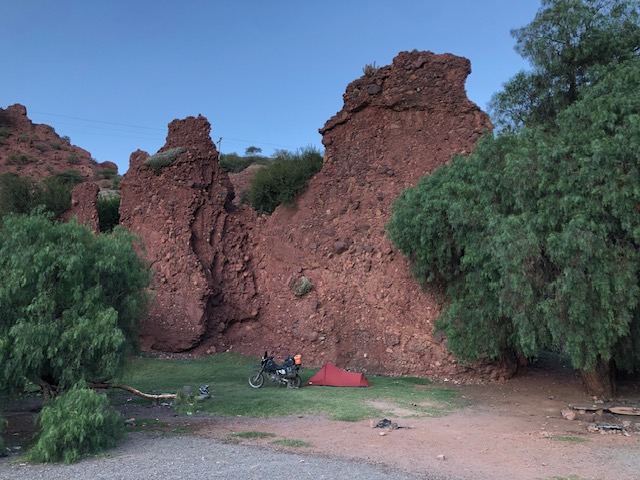
Arriving in the dark didn't show it off much, but in the morning it was splendid - a wide river bed surrounded by majestic conglomerate rock towers. It was too good to leave in a hurry, so I stayed and did some stretches in the sun (wish I could recall more of Susan's yoga class in Durango!).
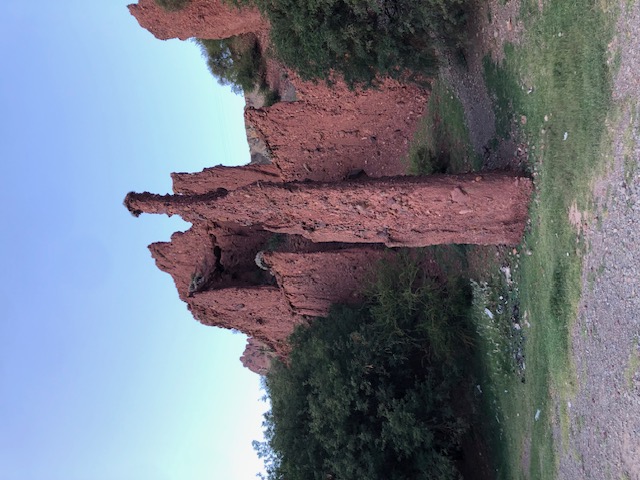
Tupiza had a bustling market going on. It was hard to capture the energy in photos. A moment after this shot, the blue hatted spud lady mimed throwing one at me. Not happy being chased by paparazzi?
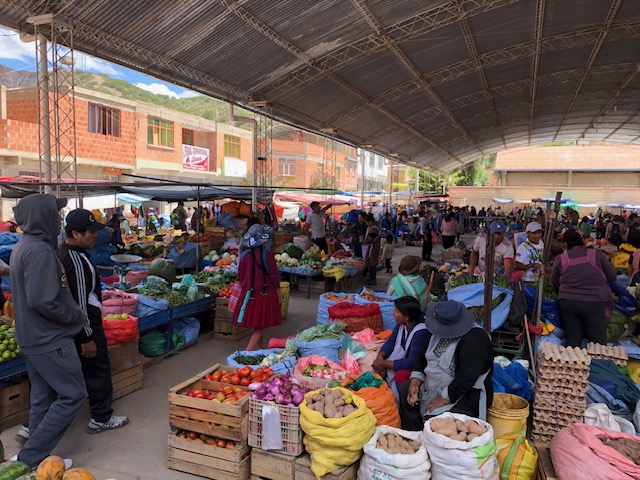

Further south there were more rocks ...
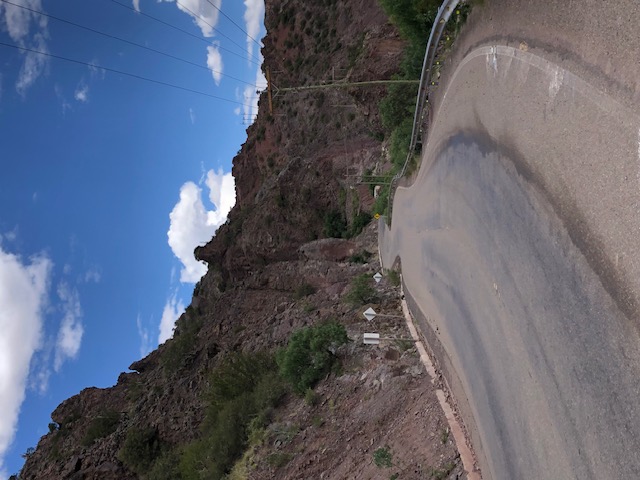
... then flat again leading to the border.
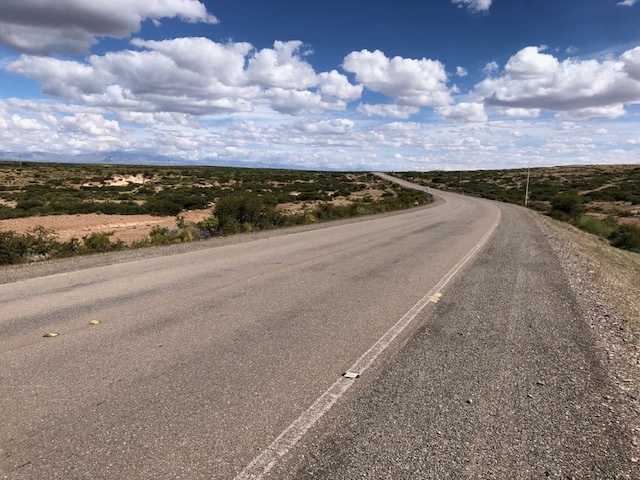
Here was a cute idea from iOverlander: camp inside an abandoned house.
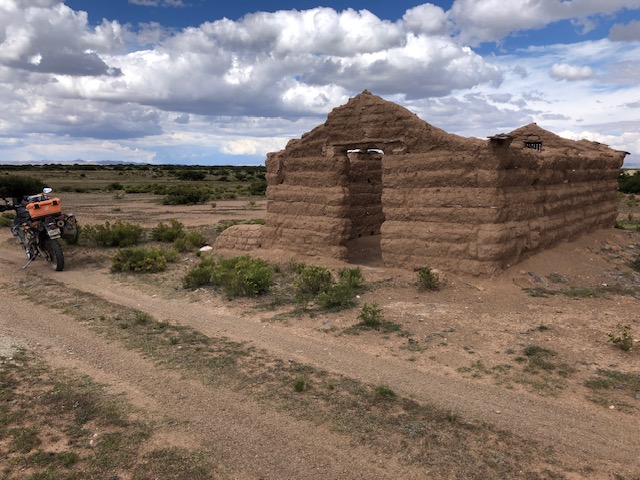
Bolivia had been intriguing. It obviously has so much more to offer, particularly up in the mountains and Amazonian area. Yet it was a tougher proposition for a westernised person.
I believe it was the least developed country so far, judging by the sparse availability of "stuff". There were towns where nothing approaching a supermarket existed. Obviously residents survived just fine, so perhaps it's simply a matter of adjusting expectations. The fuel situation was the biggest issue for a rider.
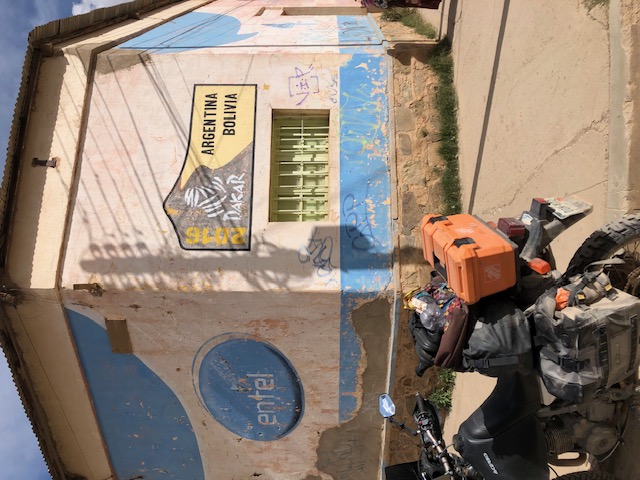
It was said that local cash is hard to obtain in Argentina. ATMs give only small amounts and charge a 10-15% fee. The word was that it was better to bring pesos from outside. So in Bolivian border town Villazón, l withdrew a shedload of Bolivian money and used one of the myriad currency traders.
Wow, the Argentinian money is something else. My money changer used a note counting machine to measure out two piles: first 200,000 pesos in 2,000 peso notes and second 100,000 pesos in 1,000 peso notes. Each was 20mm thick.
Just after collecting it all, a lady entered the shop wanting to change big denomination notes for small. We traded like for like. I was happy with a smaller pile, she was happy with notes more useful in stores.
The smallest note is 10 pesos ~1.5 Australian cents. I've got a few and I'm blowed if I know what I'll do with them. Use in the smallest room of the house, perhaps.
By that evening I had this fine collection. I wasn't sure where to stash it all. Don't tell anyone it's in the backpack's front pocket.
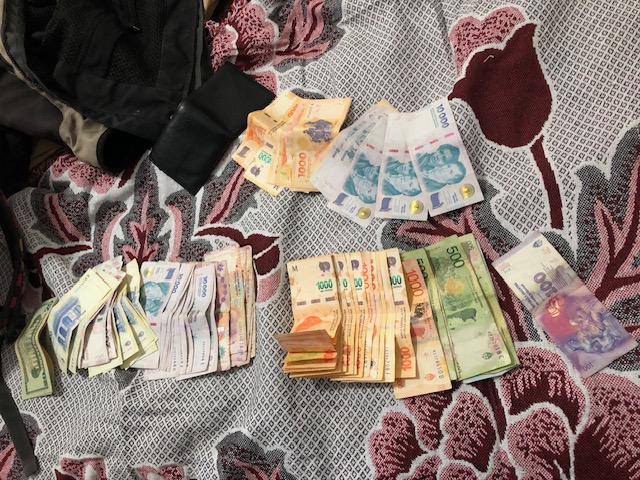
Apparently tour buses cross to/from Argentina in the mornings, clogging up immigration. Best go mid to late afternoon they said. There was still some queuing on the bridge over the Rio de la Quiaca in no man's land after exiting Bolivia ...

... and before entering Argentina.
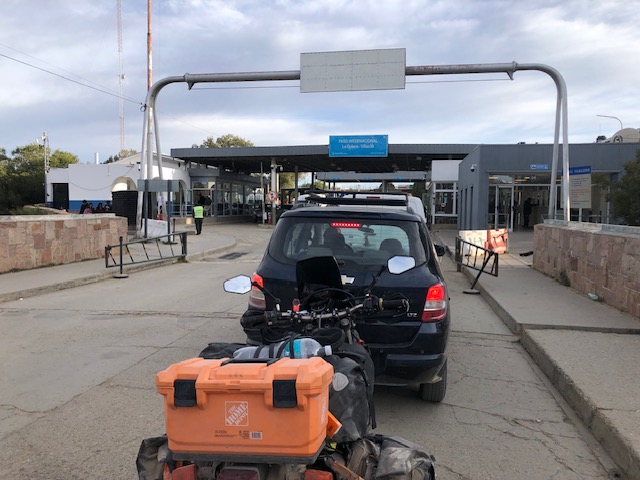
Nothing too onerous though - it was a good crossing. Most officials were welcoming, asking about the journey and giving thumbs up.
I literally went around in circles in the new country. Following the GPS to find a hotel, I kept being directed back north over the bridge. WTF? Took me some moments to twig that I'd accidentally chosen a Bolivian hotel. Perhaps I wasn't as relaxed about the frontier as I thought.
Further evidence of distraction: walking into town for a feed, watching a girl playing hopscotch on the pavement, I tripped over said pavement. Bang! Down hard on knees and palms, a bloody patch soaked into pants on one knee in seconds. Twelve countries and 25,000 miles of crazy riding in ten months had caused less injury.
I've been chasing the sun for the whole trip. The Tropic of Cancer went by in Mexico. At the time I wondered when I'd first notice old Sol to my north again - as he had been for 58 years. In recent days, it seemed he was at my zenith (riding along on a desert road, twisting head to look up, hard to tell). It was confirmed by crossing the Tropic of Capricorn.
No sign on the highway. It took a few U turns to even find the marker, in a muddy field of crops obscured by stalls selling pottery.
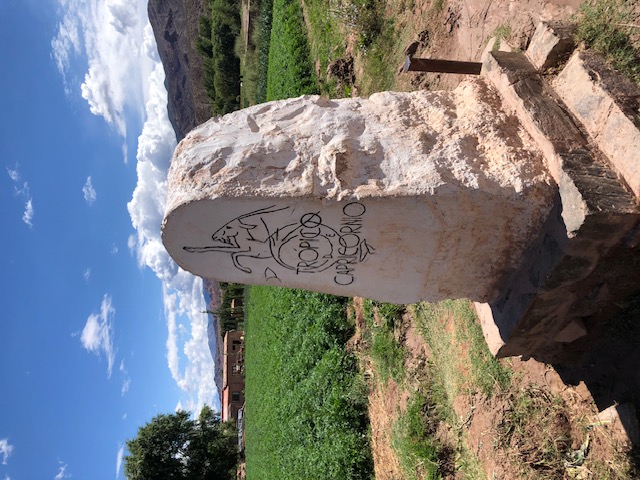
Ah, that's better - a familiar implicit compass.
Towns were neat. How lovely for those in El Carril having this view.
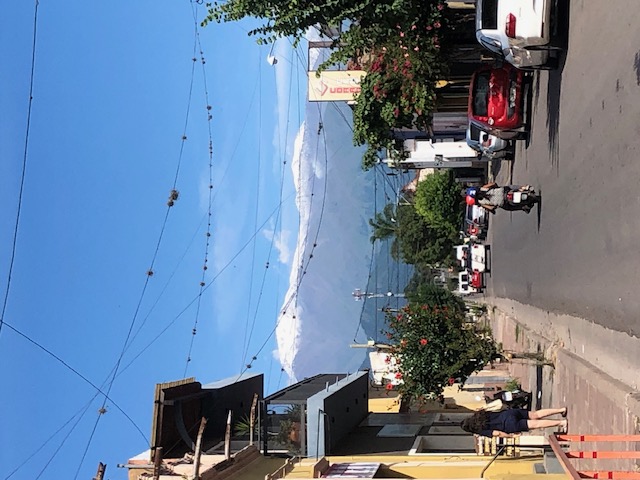
Here was a possible overnight stop. Seems the signposts for a food and drink stop may be out of date, judging by the state of the shelters.
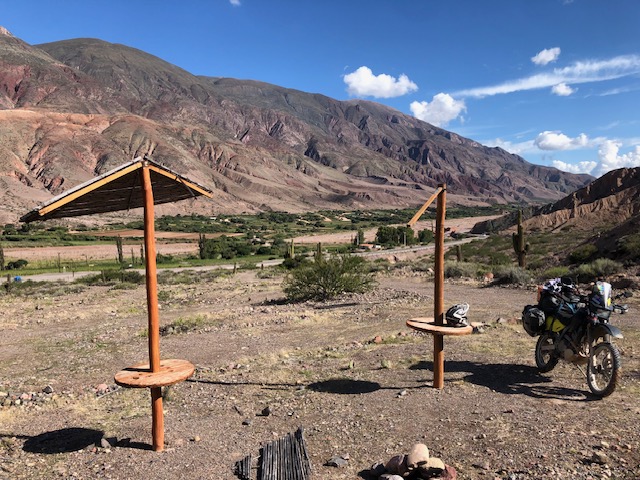
Cactus had changed appearance.
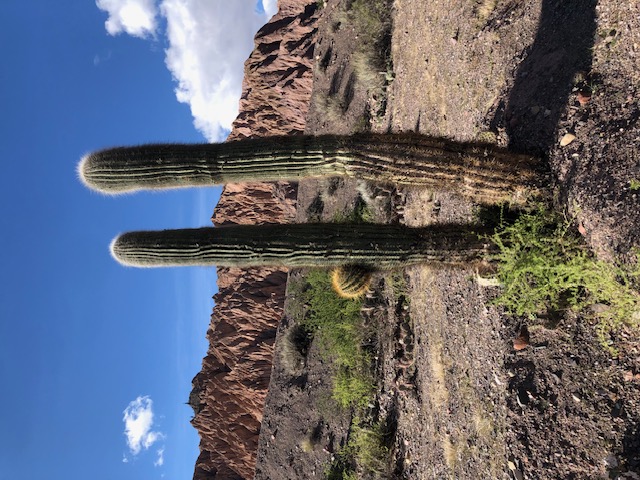
Jujuy (like Wagga Wagga - so good, they named it twice) was an eye opener to how Argentina would be from then on: so much prosperity in juxtaposition with southern Peru and Bolivia. Suddenly there were joggers, well dressed slender ladies, sane traffic and all the modern conveniences.
Argentinian women were the most striking so far. The majority of the adult female population in preceding countries had grown a prominent belly by their twenties. Sure some were padded in Argentina too, but they were in the minority. In the hot weather tanned legs below shorts and bare arms were the norm.
Why, some even approached the beauty of my own dear Kirsten (not sure whether she's reading).
With greater prosperity comes higher prices. Most items were on par with Australia. One can't complain, but it was sad to no longer have the cheap eats and lodgings.
Inflation has been crazy in recent years. Reading accomodation reviews could be misleading. "We paid 5000 pesos". Great, nice and cheap. Except that was in 2023. Now 18,000.
There were many small signs of greater wealth.
In an innocuous remote town, I had a midday powernap in this park. Despite being in near desert country and rather hot, the ground had been raked of leaf debris. In Bolivia this park would have been dusty concrete at best. Neatening it up would not have been important.
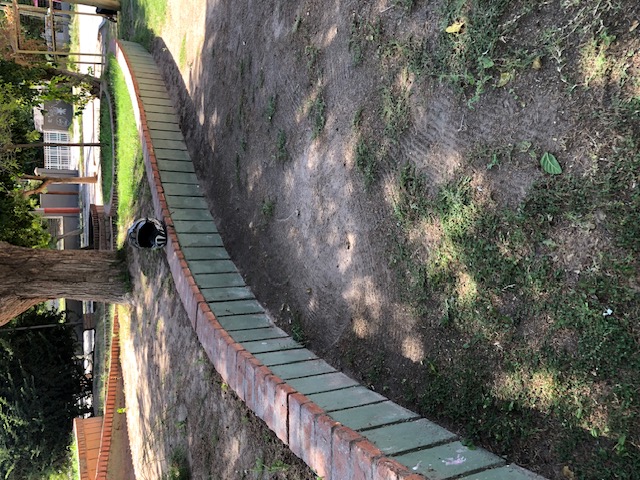
The mix of cars in any place always fascinate me. In rural Peru and Bolivia white Toyota station wagons where the most common. In Argentina European makes have dominated, especially French. Many with the dancing lion on the grille (none as quick as your old black rocket IanP). Many with the diamond (but the Meganes seem ordinary, PaulL). Many with the two chevrons (dunno anyone who'd admit to owning a Citroën).
Older models include an XM like Falcon, but with different headlights and tail lights. The badges showed "3.6" - our 221ci six.
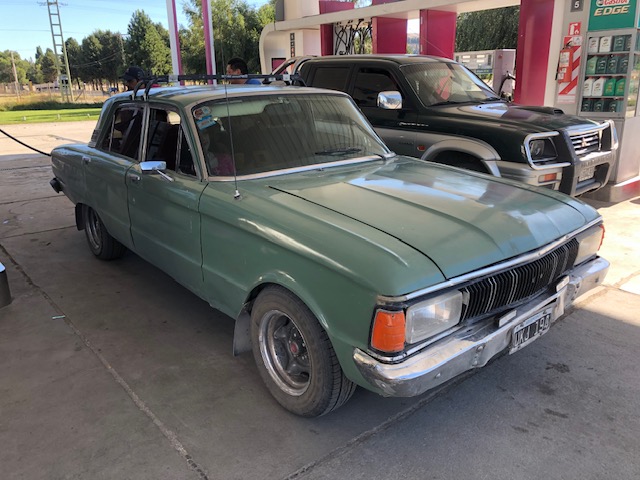

There were TC/TD Cortinas (named "Taunus" here), again with different lights each end. There was even a fastback two door. Looked great.
Some showed good taste.
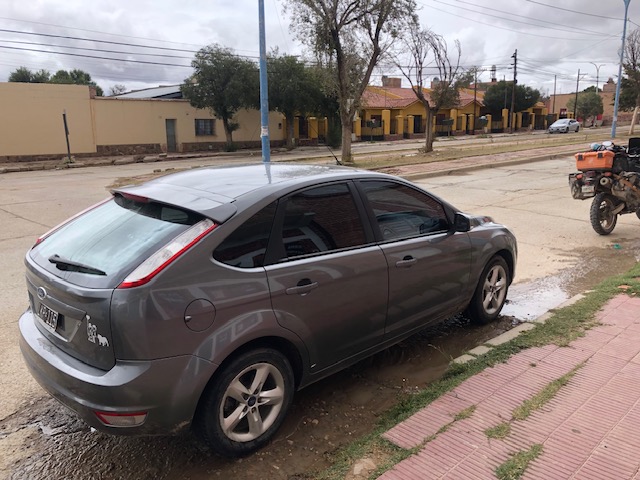
(ChrisR - a few Mark 1 Focuses around - want me to slip a Zetec into the pannier for your next blow up?)
In a servo of the same name.
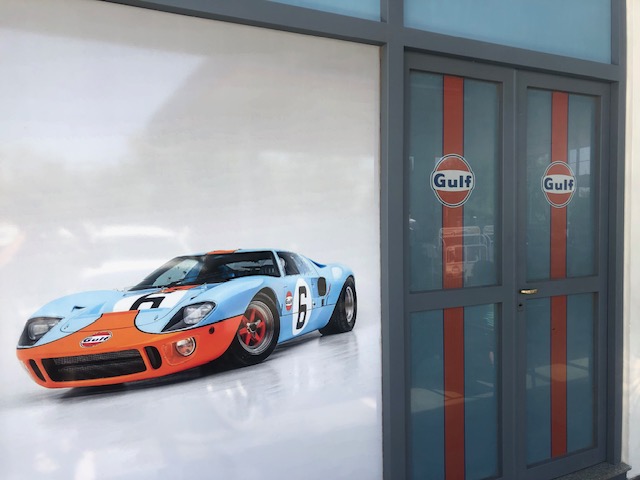
Which route to take? The iconic RN40 was the obvious choice, running 5000km from La Quiaca where I entered in the far north, all the way down. Argentinians are rightly proud of their "Ruta Quarenta".
However lesser highway 9 between Jujuy and Salta came with glowing recommendations from the motorcycling crowd - a twisty narrow blast that came with warnings of risk.
It lived up to its reputation.
It rose up into lush hills without a straight section in sight.
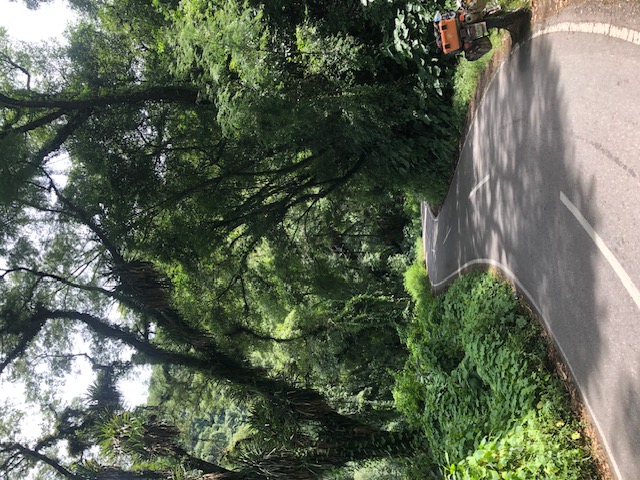
I'm sure we have pushbike lanes wider at home. On the tighter bends the centre white line went away. One at a time, please.
I'd been leapfrogging this couple, taking photos, us waving each time (truth be told, I was watching his cute pillion with her big smile).
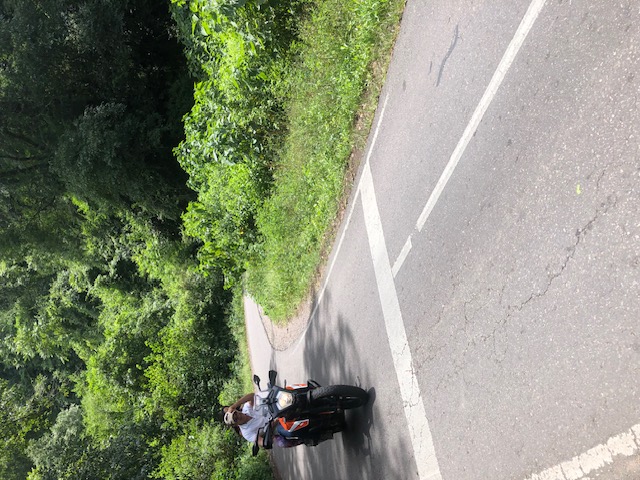
Gaggles of murderbikes came the other way, weekend riders out for a fang. Packs of hot hatches ran nose to tail, NASCAR style.
There were only two close calls. First was my fault - almost into the grille of a ute. Second was a beat up Renault hatch taking liberties with lane space.
Salta was a big city with all the mod cons. I chased up cream to keep the boot leather supple. It puzzled me that the saddlrey reopened at 5pm. It took a couple of days to realise that most places are closed from late morning until late afternoon, on account of the heat. A siesta, if you will.
For travelling in the day, this meant not having food and drink readily available. It made a lot of sense though. Indeed the evening lifestyle was easy to enjoy.
Belén was a case in point.
• Mid afternoon: dead
• 8pm: one couple were having a wine in the plaza
• 10pm: all plaza tables were full, kids played games under lights
• midnight: car horns heralded the arrival of families ready to party
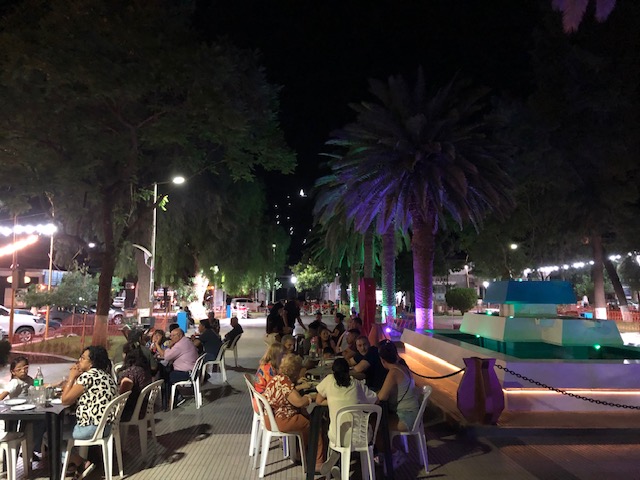
The next entertaining ride was highway 68 from Salta to Cafayate . A wide tar two laner this time, but oh so sinuous.
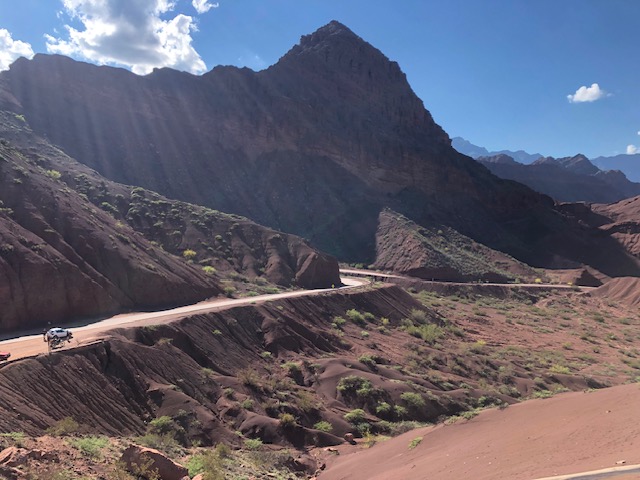
Impressive canyon features broke the ride up.
eg The Devil's Throat - a sideways bowl of rich coloured rock layers sculpted by years of water flow.
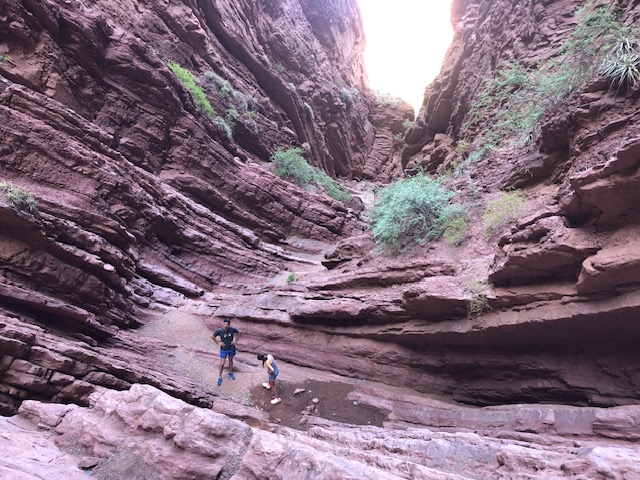
I joined RN 40 at Cafayate.
There were miles of laughs/leg openers/headaches around Cafayate. Not sure when I'd last ridden past vineyards. Definitely none with cactus in them.
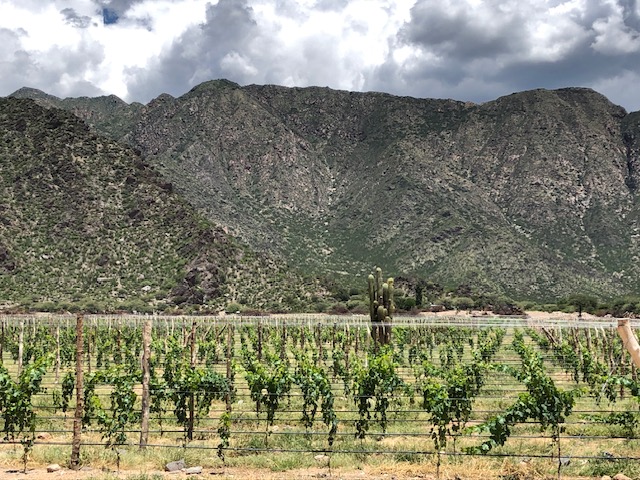
These northern parts of the 40 were usually through arid country. I'd been told that the Argentinian side of the Andes was dull desert, not worth seeing. I disagree. To my eyes it kept changing in interesting ways every few minutes.

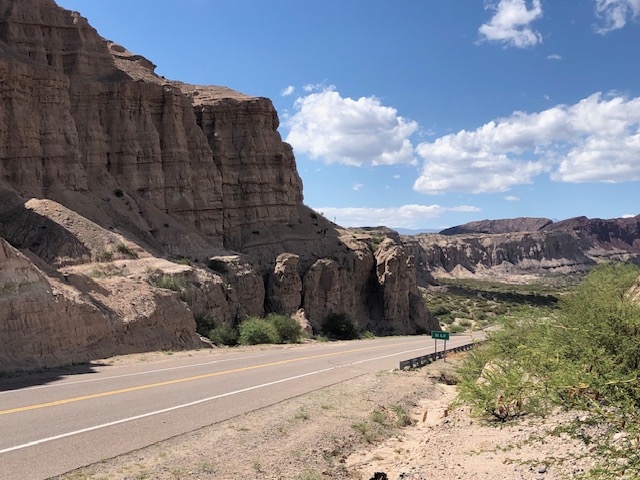
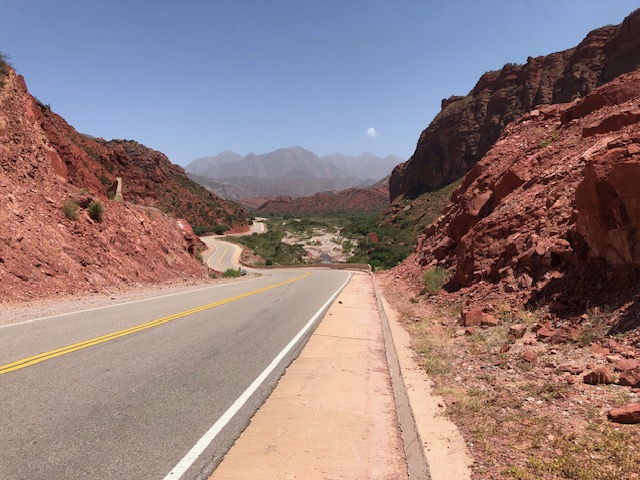
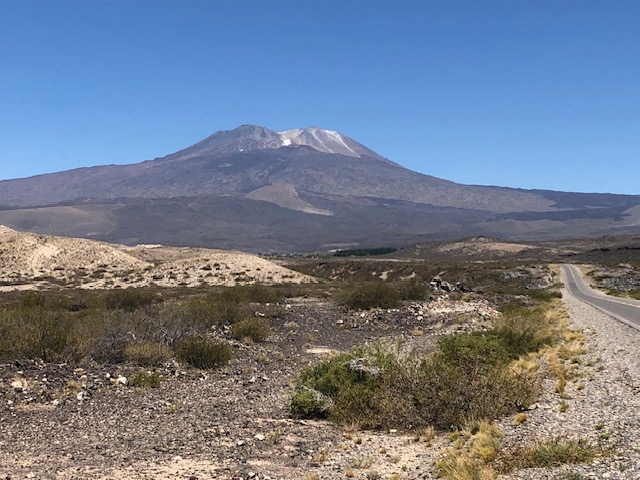
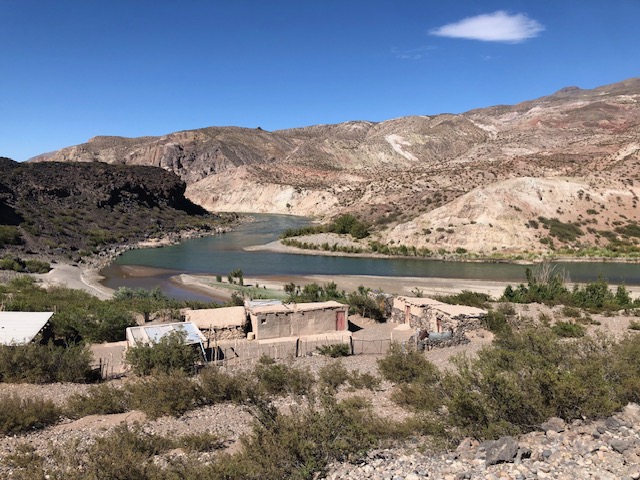
It was certainly hot at times. If the air found its way through a crack to bare skin, it was an oven blast.
Eventually there was no fencing and animal sightings were rare.
One of those rare sightings was a mob of horses, nibbling away on the verge ... but nibbling at what? I couldn't discern anything nutritious amongst the rocks.
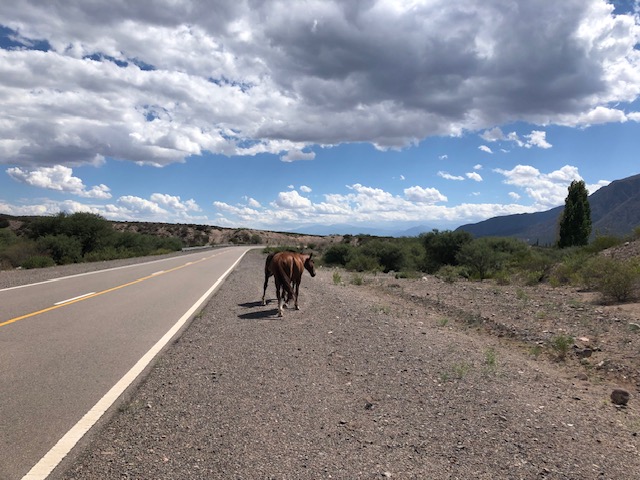
A diversion from the 40 to Talampaya National Park had been recommended. As ever my research was a bit half arsed - only when miles off track did I learn that entry was only permitted with a guide and the tour would be over two hours. Neither suited me, so I just blasted past.
The picturesque stuff in the park was well off the main road. Instead, it all looked remarkably like outback Australian drives.
I even had to watch out for emus.
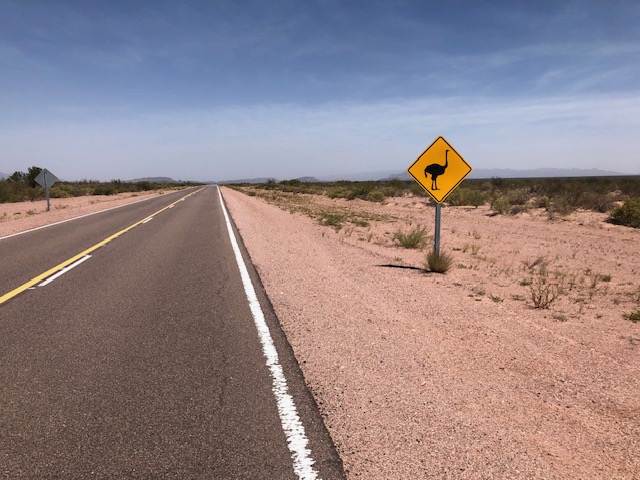
Oh well, maybe I would have more joy at Ischigualasto Park which was on the way and sounded less formal.
My second mistake for the day was a navigational cock up. By the time I realised I was on the wrong highway, Ischigualasto wasn't worth going back for.
An urgent nature break was required late in the day. A dirt side road appeared ... except it was actually just a dry creek, covered in silt. Post ablutions it was challenging to find grip in the soft sand, so I walked it out in first gear ... then somehow lost balance ... again.
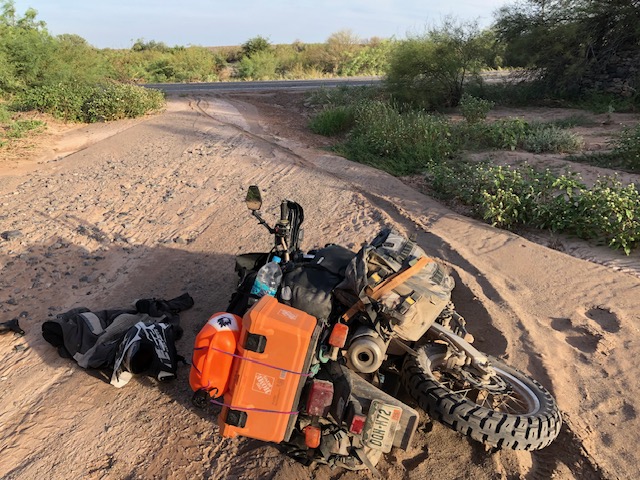
Crikey I was in a shit.
The following day wasn't awesome either - mostly due to fatigue after staying up until stupid o'clock in the morning, wasting time on the internet in a funk. It made for a set of dumb decisions over the day.
Anyway, some days are bound to be crappy. Mostly they're good. Great, in fact.
The front tyre had an odd wear pattern. Knobbied tyres often have alternating one knob / two knobs in the centre. Usually the single knobs wear much quicker than the two. The Metzler Enduro has a variation of this, wherein the knobs are angled at 45° to the centreline. Not only were alternate knobs more worn, but those on the left much more so.
Blowed if I know why.
Regardless, it made sense to grab a new tyre in Mendoza as it seemed unlikely there would be another retailer with stock for many kilometres, if at all in the rest of Argentina.
The shop was going to add 10% extra for a credit card. Horrified, I hauled out a big stash of pesos. Bummer, I had been counting on that stash for weeks ahead.
10% seemed small beer later - a hotel wanted to add 20% extra for a card. Crazy. I laughed out loud at reception. They relented.
The bike shop were happy to fit it if I could wait until 6pm. That seemed just a bit too far away, so instead I strapped it on the back for a future day. After all the 40 was all tar and surely the old tyre would go another thousand or two.
One silver lining was now being a true adventure rider, with spare tyre and fuel lashed on. Credibility at last.
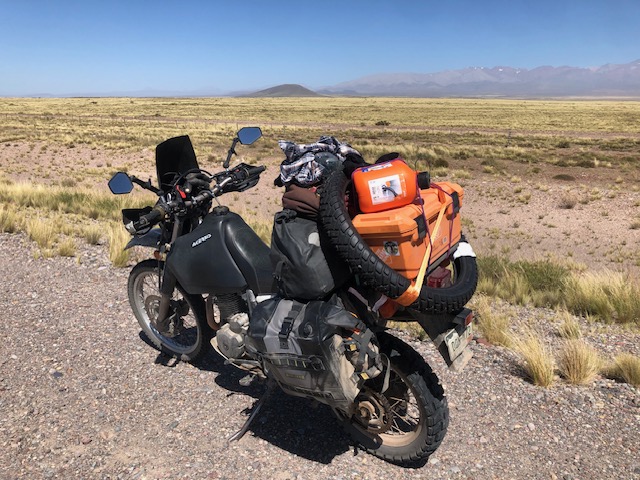
From Mexico onwards, there had been few overland / adventure bikes. Yes, I met some owners but they were generally locals to each country. This surprised me; I had presumed I'd bump into many from overseas at the big ticket tourist points.
That started to change in Argentina, particularly further south on the 40.
Suddenly many riders were waving, mostly in groups of two, three and four. The DR became a small bike compared with these machines of double the engine size. It was also the dirtiest bike, something to be proud of methinks.
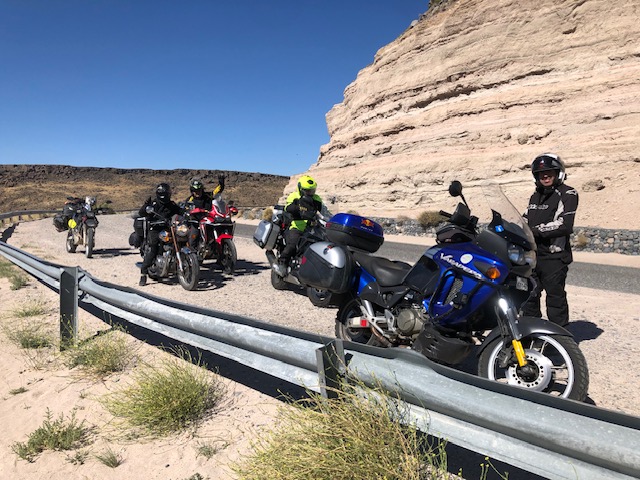
As I write from Patagonia there are now scores of overlander bikes in each town. It seems funny recalling waving Patricia down back in Colombia, because she unusually sported overlander luggage and her Peruvian flag. Now, many riders don't even wave back - that old trait of nodding a head to a stranger in a country town, but not having eye contact in a city.
Argentina has had so many more opportunities for camping, more and more as I've headed south. They've been a mix: municipal for a small fee, commercial on private land and free / wild areas.
Some examples.
Municipal next to a dam out of Jujuy. Peaceful, just a horse and a couple of friendly fishermen in the morning.
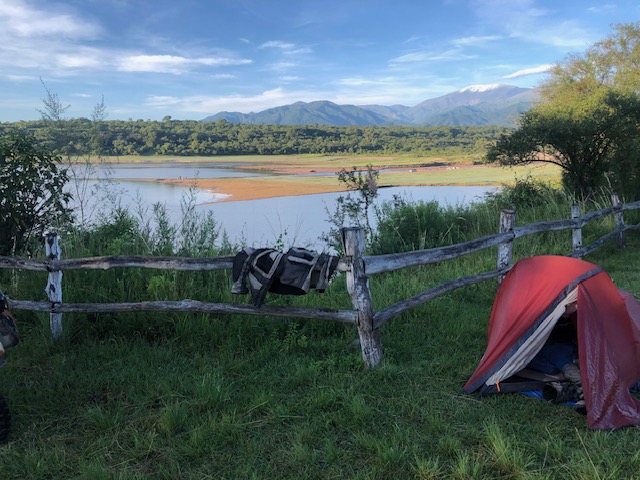
An inexplicable GPS cock up led to a cow paddock, not the idyllic waterside spot described on iOverlander. Too late, too dark to move, shrug and set up amongst the cow pats.
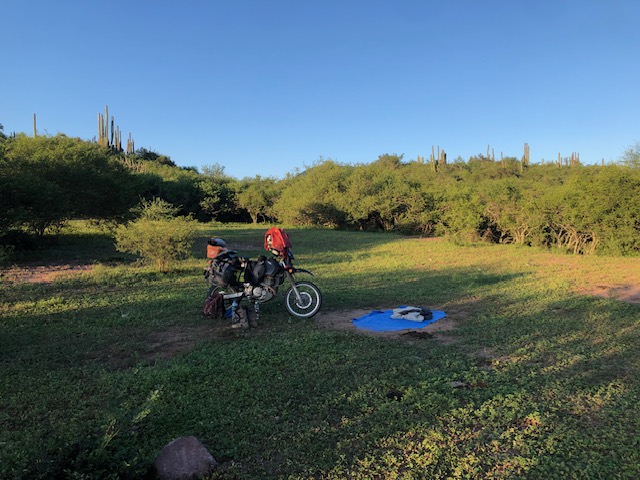
Peace just out of Las Lajas.
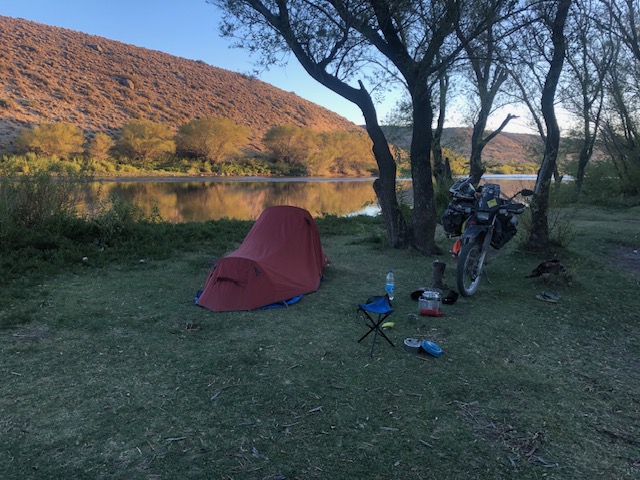
Remember how the 40 was all tar so tyre wear shouldn't be a problem? Yeah, not so much. A 80km stretch of what the locals call "ripio" caught me out. Corrugations, some tough embedded rocks and sand - nothing unusual, so up on the pegs and fang it. Smooth, good fun, in fact.
Until it didn't feel smooth any more. The front end suddenly got harsh. Surprisingly the steering didn't feel vague. Whatever - it had a puncture.

I parked it well off the road. In hindsight parking downwind on the outside of a bend was a poor choice. Many work utes and trucks threw dust while I effected a repair. Even without traffic, it was blowing a gale so dust was everywhere.
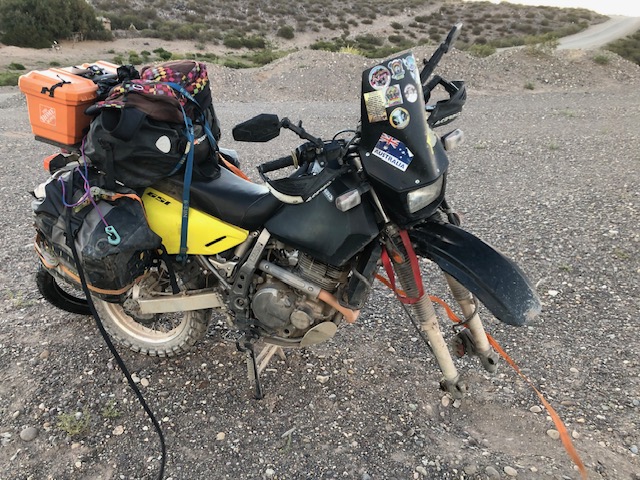
Now I'm bloody awful at changing a tyre. Even in the best of circumstances, like being in my garage (or kitchen !) with tools, light and space I take an age, leave the rims scarred and spend the whole time cursing.
This wasn't a time to expend energy swearing, so I focussed and cracked on.
First up, there was no 19mm socket for the front axle. I am 110% convinced the toolkit had one - surely it was used back in Durango for early service work. Well it wasn't there any more.
Blokes in a flagged down mining ute assured me there was a place just up the road. They then drove off. Thanks.
That set the scene for the rest of the day. I walked 1-2 km up the road, trying to hitch a ride. Many passed. None stopped.
Eventually I got to Alfredo's property. He understand my mangled communication, coming out with a socket set ... that went up to 16mm. Oh.
But what's this? A 3/4" socket - you beauty, much the same dimension.
Happy, I wandered back to my "workshop". By now the shadows were pretty long.

Again, no bastard stopped.
I'm dumb at times. In the excitement I hadn't noticed Alfredo's socket had a 1/2" drive. My ratchet was 3/8". Far out.
Fortunately, my weeny Vice Grips were a perfect fit.
So off came the wheel, old tyre and tube, on went a new tube and the new tyre.
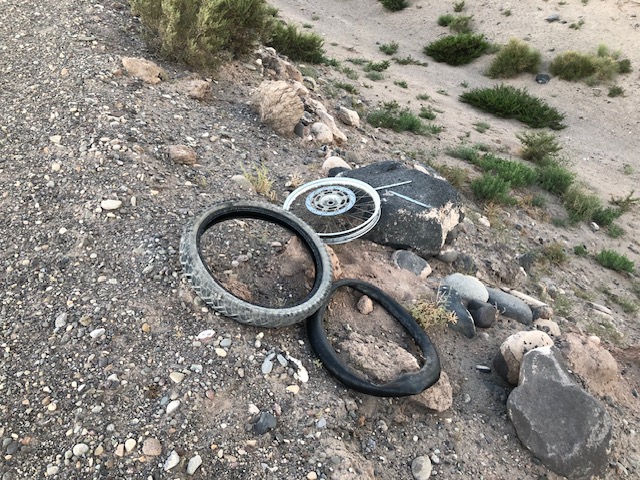
It all went smoothly, which was just as well because it ended up a job by headlamp.
Then it wouldn't pump up.
Hundreds of strokes and still flaccid.
F@#% it.
I buttoned everything up against the dust and set up camp in the ditch under a full moon.
The new day was glorious: no wind, pleasant sunshine, little traffic.
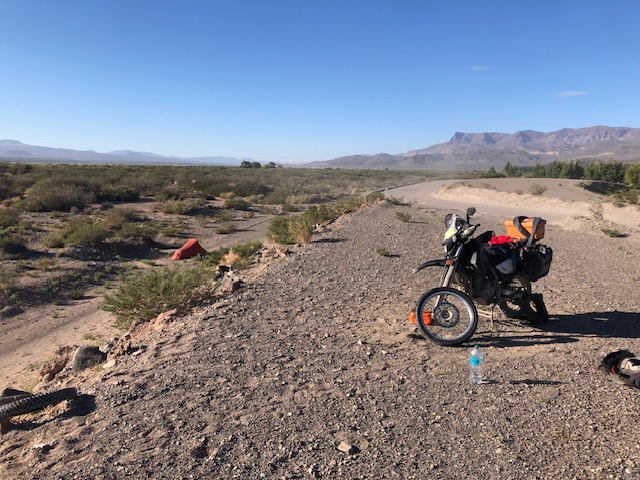
First I patched the old tube, thankful for a nearby gentle stream to find bubbles. Next was a super careful repeat.
This time it pumped up.
Sure enough, I'd holed the new tube the night before with a tyre iron. I patched it as well, given there was a convenient body of water and the glue was fresh.
I had started my own gomeria (Mexico "vulcanizadora", Guatemala "pinchazio" - tyre repair shop).

Clean up, pack, depart.
Reckon I should have waited until 6pm for the bike shop?

